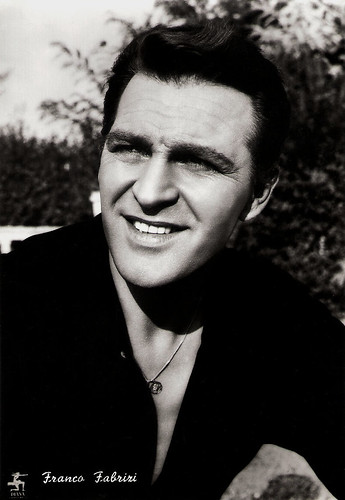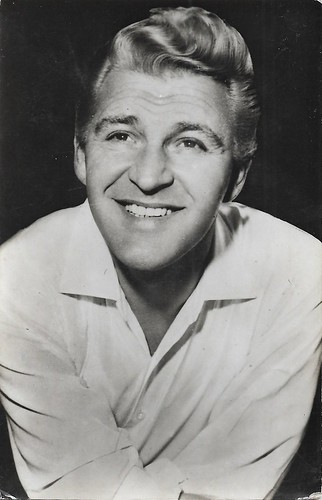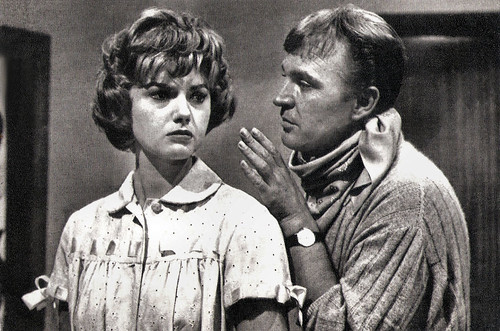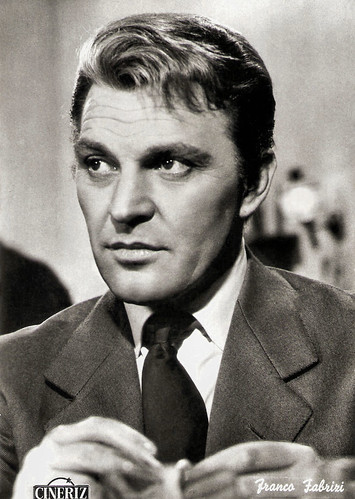
Italian postcard by Turismofoto, no. 80.

Italian postcard by Rotalfoto, Milano, no. 444. Photo: Titanus.Franco Fabrizi in Il Bidone/The Swindlers (Federico Fellini, 1955).
The template for all young-men-stuck-in-adolescence movies
Franco Fabrizi was born in Cortemaggiore, Italy in 1926 (according to Wikipedia, IMDb says 1916). He was the son of a barber and of a cinema cashier.
In 1947, Fabrizi started his career as a model and an actor in Fotoromanzi (the Italian fotonovelas). He also starred in several revues and stage plays.
His film debut was a supporting role as a fashion show presenter in Michelangelo Antonioni's first feature film, the drama Cronaca di un amore/Story of a Love Affair (1950). Despite some neorealist background, the film was not fully compliant with the contemporary Italian neorealist style both in its story and image, featuring upper-class characters portrayed by stars like Massimo Girotti and Lucia Bosè. The film won two Nastro d’Argento (Italian National Syndicate of Film Journalists Silver Ribbon) awards in 1951.
Fabrizi's film debut was followed by several bit parts and a bigger role in Carica Eroica/Heroic Charge (Francesco De Roberti, 1952).
The following year, Fabrizi played Fausto in Federico Fellini's I vitelloni/The Spivs (1953), a part that made him known. In this comedy-drama, he co-starred with Alberto Sordi and Franco Interlenghi in a story of five small-town youths at crucial turning points in their lives. Fausto is the leader of the pack, who marries his sweetheart, but finds himself constantly distracted by other women.
Fellini’s film, a pivotal work in the director's artistic evolution, has autobiographical elements that mirror important societal changes in 1950s Italy. The film received both the 1953 Venice Film Festival Silver Lion, and an Academy Award nomination for Best Writing.
Elbert Ventura at AllMovie: “essentially the template for all young-men-stuck-in-adolescence movies, I Vitelloni has inspired filmmakers as disparate as Martin Scorsese and Giuseppe Tornatore. Generous and ultimately heart-breaking, I Vitelloni may well be the most big-hearted of the Italian master's movies.”
Elbert Ventura at AllMovie: “essentially the template for all young-men-stuck-in-adolescence movies, I Vitelloni has inspired filmmakers as disparate as Martin Scorsese and Giuseppe Tornatore. Generous and ultimately heart-breaking, I Vitelloni may well be the most big-hearted of the Italian master's movies.”
From then on, Fabrizi was inextricably linked to the character of a full-time lady-killer, a young not-so-young philanderer who refuses to grow up. But outside the cinema, the gossip links also linked him to a long line of actresses and society doyennes.

Italian postcard by Bromofoto, Milano, no. 1057. Photo: Diana. Franco Fabrizi in Racconti Romani/Roman Tales (Gianni Franciolini, 1955).

Spanish postcard by P.V.P., no. 3031. Franco Fabrizi in Il Bidone/The Swindlers (Federico Fellini, 1955).
Franco Fabrizi reprised the character of the opportunistic philanderer in films like the comedy Schiava del peccato (Raffaello Matarazzo, 1954), and the drama La romana/Woman of Rome (Luigi Zampa, 1954) featuring Gina Lollobrigida.
He reunited with Fellini for Il bidone/The Swindlers (Federico Fellini, 1955) with Broderick Crawford, Richard Basehart, and Giulietta Masina. That same year, he also worked again with Antonioni at the drama Le Amiche/The Girlfriends (Michelangelo Antonioni, 1955), also starring Eleonora Rossi Drago and Gabriele Ferzetti.
Adapted from Cesare Pavese's 1949 novel 'Tra donne sole', the film is about a young woman who returns to her native Turin to set up a new fashion salon and becomes involved with a troubled woman and her three wealthy women friends. Le Amiche received the Venice Film Festival Silver Lion Award in 1955, and the Nastro d’Argento awards for Best Director and Best Supporting Actress (Valentina Cortese) in 1956.
In the following years, he appeared in the comedy Calabuch/The Rocket From Calabuch (Luis García Berlanga, 1956), starring Edmund Gwenn in his last film role, the French-Italian drama Sait-on jamais.../No Sun in Venice (Roger Vadim, 1957) with Françoise Arnoul, the crime film Un maledetto imbroglio/The Facts of Murder (Pietro Germi, 1959) with Claudia Cardinale, and he had a small part in Le notti di Cabiria/Nights of Cabiria (Federico Fellini, 1957) starring Giulietta Masina.

Romanian postcard by Casa Filmului Acin, no. 214. Sylva Koscina and Franco Fabrizi in Le Sorprese dell'amore/Surprise of Love (Luigi Comencini, 1959). The film is called in Romania Surprizele dragostel.

Romanian postcard by Casa Filmului Acin, no. 12. Sylva Koscina and Franco Fabrizi in Le Sorprese dell'amore/Surprise of Love (Luigi Comencini, 1959). The film is called in Romania Surprizele dragostel.
During the 1960s, Franco Fabrizi was mainly relegated to character roles in Italian, French and Spanish minor productions, like the Peplum Orazi e Curiazi/Duel of Champions (Ferdinando Baldi, Terence Young, 1961), starring Alan Ladd, or the Totó comedy Il comandante/The Commandant (Paolo Heusch, 1963).
However, in between, he still appeared in some major works of the Italian cinema, including the Italian-Cypriot drama Il relitto/The Wastrel (Michael Cacoyannis,1961), which was entered into the 1961 Cannes Film Festival, the Commedia all'italiana A Difficult Life/Una vita difficile (Dino Risi, 1961) with Alberto Sordi, and the sex comedy Signore & Signori/The Birds, the Bees and the Italians (Pietro Germi 1966).
At the 1966 Cannes Film Festival, Signore & Signori shared the Palme d’or, the Grand Prix with Un homme et une femme/A Man and a Woman (Claude Lelouch, 1966). Other interesting films were the comedy-drama Una questione d'onore/A Question of Honour (Luigi Zampa, 1965), Roma bene/Good Rome (Carlo Lizzani, 1971), and the classic Morte a Venezia/Death in Venice (Luchino Visconti, 1971) starring Dirk Bogarde and based on the novella 'Der Tod in Venedig' by the German author Thomas Mann.
A huge popular success in Italy was the crime film La polizia ringrazia/Execution Squad (Steno, 1972). The film is considered as the initiator of the Poliziottesco genre, the Italian police crime film. He played a supporting part in the French-Italian surreal farce Touche pas à la femme blanche/Don't Touch The White Woman! (Marco Ferreri, 1974) starring Marcello Mastroianni and Catherine Deneuve.
Then he was the show host in Fellini’s Ginger e Fred/Ginger and Fred (Federico Fellini, 1986) starring Marcello Mastroianni and Giulietta Masina as the Italian impersonators of Fred Astaire and Ginger Rogers who reunite after thirty years of retirement for a vulgar and bizarre television extravaganza.
It was followed by a part in the comedy Il piccolo diavolo/The Little Devil (Roberto Benigni, 1988) with Walther Matthau as a cynical, dry-humoured priest who is followed by a little demon (Roberto Benigni), whom he exorcised. His final film was the comedy Ricky e Barabba/Ricky and Barrabas (Christian De Sica, 1992).
In 1993 he had a serious car accident from which he recovered; immediately after, however, it manifested the illness that led him to death. Franco Fabrizi died of bowel cancer in 1995 in his home village Cortemaggiore. He was 69.

Italian postcard by Bromofoto, Milano, no. 1744. Photo: Cineriz.

East-German postcard by VEB Progress Filmvertrieb, Berlin, no. 1343, 1960.
Sources: Elbert Ventura (AllMovie), Wikipedia (English and Italian), and IMDb.

Italian postcard by Bromofoto, Milano, no. 1057. Photo: Diana. Franco Fabrizi in Racconti Romani/Roman Tales (Gianni Franciolini, 1955).

Spanish postcard by P.V.P., no. 3031. Franco Fabrizi in Il Bidone/The Swindlers (Federico Fellini, 1955).
Reprising the character of the opportunistic philanderer
Franco Fabrizi reprised the character of the opportunistic philanderer in films like the comedy Schiava del peccato (Raffaello Matarazzo, 1954), and the drama La romana/Woman of Rome (Luigi Zampa, 1954) featuring Gina Lollobrigida.
He reunited with Fellini for Il bidone/The Swindlers (Federico Fellini, 1955) with Broderick Crawford, Richard Basehart, and Giulietta Masina. That same year, he also worked again with Antonioni at the drama Le Amiche/The Girlfriends (Michelangelo Antonioni, 1955), also starring Eleonora Rossi Drago and Gabriele Ferzetti.
Adapted from Cesare Pavese's 1949 novel 'Tra donne sole', the film is about a young woman who returns to her native Turin to set up a new fashion salon and becomes involved with a troubled woman and her three wealthy women friends. Le Amiche received the Venice Film Festival Silver Lion Award in 1955, and the Nastro d’Argento awards for Best Director and Best Supporting Actress (Valentina Cortese) in 1956.
In the following years, he appeared in the comedy Calabuch/The Rocket From Calabuch (Luis García Berlanga, 1956), starring Edmund Gwenn in his last film role, the French-Italian drama Sait-on jamais.../No Sun in Venice (Roger Vadim, 1957) with Françoise Arnoul, the crime film Un maledetto imbroglio/The Facts of Murder (Pietro Germi, 1959) with Claudia Cardinale, and he had a small part in Le notti di Cabiria/Nights of Cabiria (Federico Fellini, 1957) starring Giulietta Masina.

Romanian postcard by Casa Filmului Acin, no. 214. Sylva Koscina and Franco Fabrizi in Le Sorprese dell'amore/Surprise of Love (Luigi Comencini, 1959). The film is called in Romania Surprizele dragostel.

Romanian postcard by Casa Filmului Acin, no. 12. Sylva Koscina and Franco Fabrizi in Le Sorprese dell'amore/Surprise of Love (Luigi Comencini, 1959). The film is called in Romania Surprizele dragostel.
The initiator of the Poliziottesco genre
During the 1960s, Franco Fabrizi was mainly relegated to character roles in Italian, French and Spanish minor productions, like the Peplum Orazi e Curiazi/Duel of Champions (Ferdinando Baldi, Terence Young, 1961), starring Alan Ladd, or the Totó comedy Il comandante/The Commandant (Paolo Heusch, 1963).
However, in between, he still appeared in some major works of the Italian cinema, including the Italian-Cypriot drama Il relitto/The Wastrel (Michael Cacoyannis,1961), which was entered into the 1961 Cannes Film Festival, the Commedia all'italiana A Difficult Life/Una vita difficile (Dino Risi, 1961) with Alberto Sordi, and the sex comedy Signore & Signori/The Birds, the Bees and the Italians (Pietro Germi 1966).
At the 1966 Cannes Film Festival, Signore & Signori shared the Palme d’or, the Grand Prix with Un homme et une femme/A Man and a Woman (Claude Lelouch, 1966). Other interesting films were the comedy-drama Una questione d'onore/A Question of Honour (Luigi Zampa, 1965), Roma bene/Good Rome (Carlo Lizzani, 1971), and the classic Morte a Venezia/Death in Venice (Luchino Visconti, 1971) starring Dirk Bogarde and based on the novella 'Der Tod in Venedig' by the German author Thomas Mann.
A huge popular success in Italy was the crime film La polizia ringrazia/Execution Squad (Steno, 1972). The film is considered as the initiator of the Poliziottesco genre, the Italian police crime film. He played a supporting part in the French-Italian surreal farce Touche pas à la femme blanche/Don't Touch The White Woman! (Marco Ferreri, 1974) starring Marcello Mastroianni and Catherine Deneuve.
Then he was the show host in Fellini’s Ginger e Fred/Ginger and Fred (Federico Fellini, 1986) starring Marcello Mastroianni and Giulietta Masina as the Italian impersonators of Fred Astaire and Ginger Rogers who reunite after thirty years of retirement for a vulgar and bizarre television extravaganza.
It was followed by a part in the comedy Il piccolo diavolo/The Little Devil (Roberto Benigni, 1988) with Walther Matthau as a cynical, dry-humoured priest who is followed by a little demon (Roberto Benigni), whom he exorcised. His final film was the comedy Ricky e Barabba/Ricky and Barrabas (Christian De Sica, 1992).
In 1993 he had a serious car accident from which he recovered; immediately after, however, it manifested the illness that led him to death. Franco Fabrizi died of bowel cancer in 1995 in his home village Cortemaggiore. He was 69.

Italian postcard by Bromofoto, Milano, no. 1744. Photo: Cineriz.

East-German postcard by VEB Progress Filmvertrieb, Berlin, no. 1343, 1960.
Sources: Elbert Ventura (AllMovie), Wikipedia (English and Italian), and IMDb.
No comments:
Post a Comment